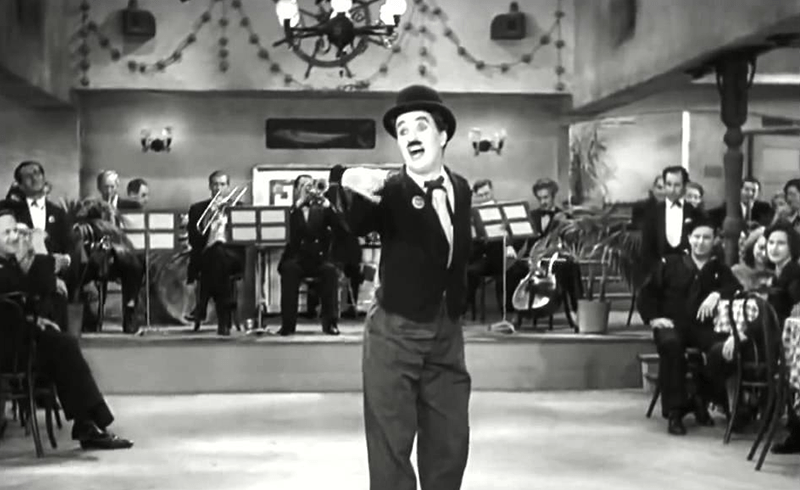From Modern Times, this song of multi-lingual gibberish was the first time Chaplin’s voice was heard onscreen
Some four decades before David Byrne and Talking Heads empowered people to “stop making sense,” Charlie Chaplin did just that in “The Nonsense Song,” which he wrote and performed in his 1936 movie Modern Times. It was his first talkie and also the final film to feature his iconic signature onscreen self, the Little Tramp.
Even among extremely talented people, Chaplin stood out. He was one of those rare humans who seemed to have unlimited talent and ability. Arguably the greatest of the silent clowns from the pre-Talkies era, he was also the writer of his movies, the director, producer, and even the owner of the movie studio where he made his masterpieces (at La Brea and Sunset in Hollywood, now Henson.)
He was the first truly international movie star, adored by fans around the world, none of whom needed any translation to understand the humor and humanity of Charlie’s silent movies.
Videos by American Songwriter
And more: He was also a composer of his own film scores, which he accomplished always with a “musical secretary” to notate, arrange and orchestrate his musical ideas, as well as conduct the orchestra while recording. For Modern Times, that role was played by David Raksin, who went on to become one of Hollywood’s great film scorers.
Chaplin was also a songwriter of many songs, which were written for and used in his later sound films. The most famous song that he wrote is “Smile,” which we delved into here. But as we explain in length, Chaplin did not write “Smile” as a song. Its melody is adapted from his score for Modern Times, and turned into a song, without Chaplin’s participation, by John Turner and Geoffrey Parsons,
However, with the advent of sound pictures, Charlie began writing full-fledged songs. The first talking film, Warner Brothers’ The Jazz Singer, starring Al Jolson, was created in 1927, ushering in the age of Talikes while sounding a slow death knell for silent movies, Chaplin kept making silents until 1936, when he made Modern Times. It was his first talkie, a reflection on the dehumanizing impact of industrialization on factory workers made to feel like cogs in a machine.

He considered having the Little Tramp speak onscreen for the first time, but realized it destroyed the universal, poetic charm of the character. Instead the Tramp remains silent even in a talkie, like Harpo Marx in all the Marx Brothers films. This contrast amplifies the poignant poetry of the character more than ever, now a symbol of simpler times, a cog that doesn’t fit in this modern machine.
Though the Tramp never speaks in Modern Times, he does sing. The first time Chaplin’s voice was ever heard on screen was in song. A song which he wrote himself, and which reflected his universal whimsy by mixing up many languages into a global gumbo of pure gibberish. In the scene, The Tramp loses the real lyrics to the song, which he had inscribed on his shirt-cuff, and so improvises instead this charged, multi-lingual lyric of inspired nonsense. It was based on a 1917 French hit called “’Titine, Je cherche a Titine” performed by ‘ Léo Daniderff, who also wrote the music. The original French lyrics are by Bertal, Maubon and Lemonnier.
Chaplin used the same melody, and so the song is credited to both Daniderff and Chaplin.
The lost lyrics on his cuff were these:
A pretty girl and a gay old mare flirted on the boulevard
He was a fat old thing but his diamond ring
The lyrics he sings are these:
Se bella giu satore
Je notre so cafore
Je notre si cavore
Je la tu la ti la twah
La spinash o la bouchon
Cigaretto Portabello
Si rakish spaghaletto
Ti la tu la ti la twah
Senora pilasina
Voulez-vous le taximeter?
Le zionta su la seata
Tu la tu la tu la wa
Sa montia si n’amora
La sontia so gravora
La zontcha con sora
Je la possa ti la twah
Je notre so lamina
Je notre so cosina
Je le se tro savita
Je la tossa vi la twah
Se motra so la sonta
Chi vossa l’otra volta
Li zoscha si catonta
Tra la la la la la la
End of Chaplin Songs, Part 1. Stay tuned for Part 2, Charlie Chaplin writes “Rock and Roll.”
See “Behind The Song: “Smile” by Charlie Chaplin
